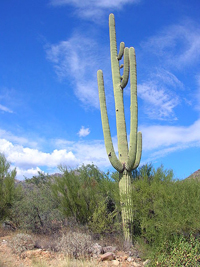It’s that time of year when garden centres – and even supermarkets – are piled high with Christmas cacti (Schlumbergera russelliana). But unlike the more familiar and disappointing poinsettias, these plants can last for many years, not just for a few weeks over the festive season.
The key to looking after cacti is to think about their natural habitat. It may come as a surprise to some people, but the plants we call “cacti” come in two very different types – the desert varieties, which are usually prickly and built for storing water, and the epiphytes, which are strappy and prickle-less and grow on trees in the jungle. All come from the New World.
Only recently have I realised this – in my youth I knew only the desert kind – which strictly speaking grow in semi-desert, as nothing grows in proper desert.
You know the sort if you have watched westerns – those big Arizona cacti known as saguaro (Carnegiea gigantea).
At the age of about five my curiosity earned me a nasty needle in the finger and out of spite I cut the top off my mother’s small “prickly pear” (Opuntia) with scissors. I was sent to bed with no supper and the cactus was assigned to the bin.
Then I had a maiden aunt with a small greenhouse lined with benches covered with hundreds of small round, grey, cushion cacti which all looked uniformly dry and boring and never flowered, as far as I can recall.
Apart from that, I didn’t think about cacti for decades. Then one summer I visited an aged relative in Yorkshire and I have to say I was very impressed by the resilience of her Easter cactus (Hatiora gaertneri) – another one of those jungle cacti. She just did not water plants at all and the cactus, kept in a dark room, looked totally sucked dry. But a few days of watering and it looked as good as new and ready to face another period of neglect.
I’m not saying this is ideal treatment, but it does give hope that this and other epiphytic cacti might be pretty easy to care for.
OK, so that’s the Easter cactus, which tends to flower around March/April/May. As well as Hatiora gaertneri, this red-flowering variety is sometimes called Rhipsalidopsis gaertneri and has in the past been called Schlumbergera gaertneri. I now have one of my own, although it is flowerless at this time of year.
This brings us to the wonderful Christmas cactus, Schlumbergera russelliana. A quick look at the flowers shows why botanists now realise the Hatiora and Schlumbergera are not that closely related. The Hatiora flowers have radial symmetry like a daisy, while the Schlumbergera is bilaterally symmetrical, like a shrimp.
Both have strap-like, segmented stems, although the Hatiora has almost rectangular segments, rounded at the ends, while the Schlumbergera has almost triangular, toothed segments.
How to look after these epiphytic cacti? Well they grow in warm, humid jungles, where, growing from trees, they tolerate shady conditions. They are happy in bright, indirectly lit spots. Mine are on window ledges on the shady side of the house. On the other hand, desert cacti are native to dry areas and are happiest in full sun.
Epiphytic cacti need to be kept very moist when they are growing and blooming, but the rest of the time they are OK to become dry between waterings. However, the potting compost of desert cacti should be allowed to dry out completely between waterings when the plants are actively growing, but during their resting period should be watered very sparingly.
Both kinds of cacti generally tolerate normal indoor humidity levels. Epiphytic cacti don’t mind breezes, but desert cacti hate drafts.
The Easter cactus needs fertiliser and more water during late winter and early spring when it is actively growing and producing flower buds, while the Christmas cactus is active during autumn and winter and rest during the summer. Out of the growing season their needs are minimal.
Desert cacti grow successfully in the well-draining commercial cactus potting soil sold in most garden centres, but epiphytic ones need a richer soil that can hold water. Most of these are fine in a standard soil-less potting compost.
Having mastered these two simple jungle cacti, I am now tempted to take on one of the more ambitious – and amazing – Epiphyllum hybrids…
Useful links:
British Cactus & Succulent Society
Abbey Brook Cacti
Glenhirst Cactus Nursery
More Epiphyllums 1
More Epiphyllums 2









wow ! i��ll give that a go, i tend not to buy roses as? after a day they droop